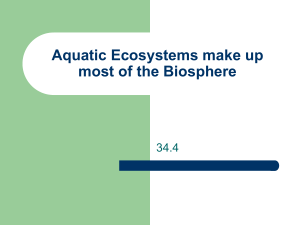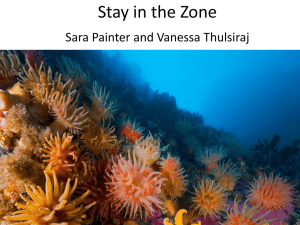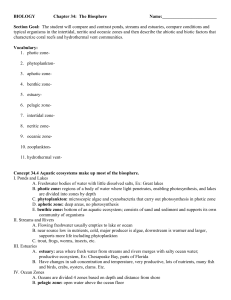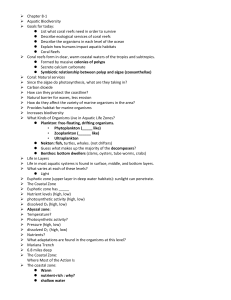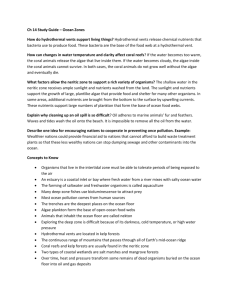Key Terms photic zone intertidal zone phytoplankton neritic zone
advertisement
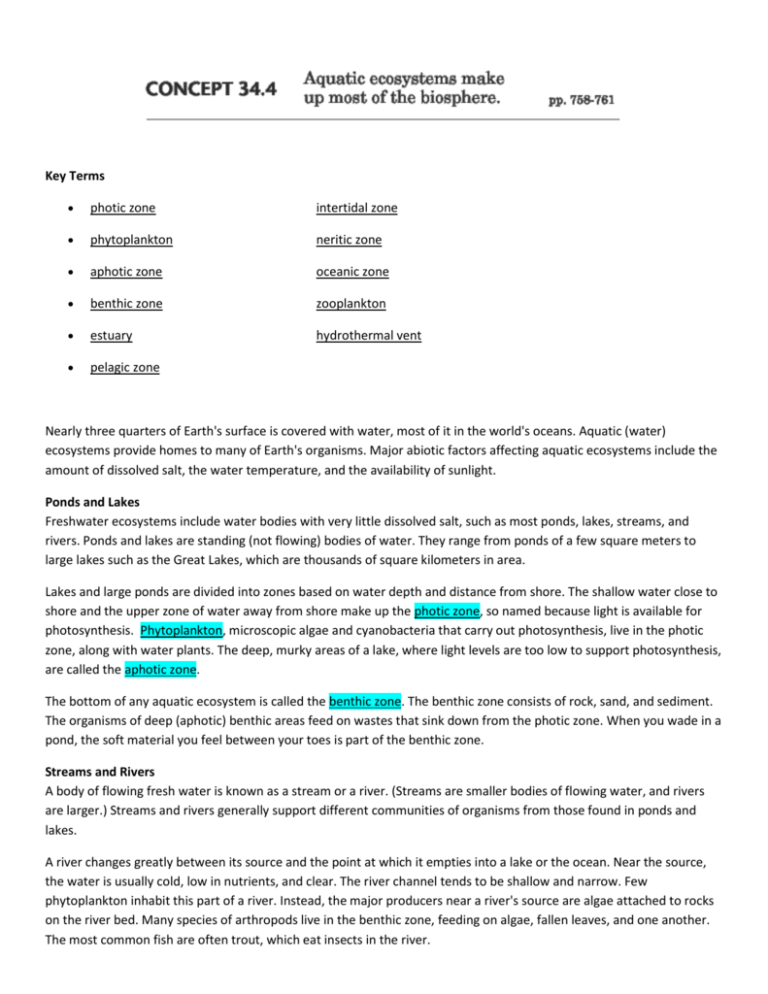
Key Terms photic zone intertidal zone phytoplankton neritic zone aphotic zone oceanic zone benthic zone zooplankton estuary hydrothermal vent pelagic zone Nearly three quarters of Earth's surface is covered with water, most of it in the world's oceans. Aquatic (water) ecosystems provide homes to many of Earth's organisms. Major abiotic factors affecting aquatic ecosystems include the amount of dissolved salt, the water temperature, and the availability of sunlight. Ponds and Lakes Freshwater ecosystems include water bodies with very little dissolved salt, such as most ponds, lakes, streams, and rivers. Ponds and lakes are standing (not flowing) bodies of water. They range from ponds of a few square meters to large lakes such as the Great Lakes, which are thousands of square kilometers in area. Lakes and large ponds are divided into zones based on water depth and distance from shore. The shallow water close to shore and the upper zone of water away from shore make up the photic zone, so named because light is available for photosynthesis. Phytoplankton, microscopic algae and cyanobacteria that carry out photosynthesis, live in the photic zone, along with water plants. The deep, murky areas of a lake, where light levels are too low to support photosynthesis, are called the aphotic zone. The bottom of any aquatic ecosystem is called the benthic zone. The benthic zone consists of rock, sand, and sediment. The organisms of deep (aphotic) benthic areas feed on wastes that sink down from the photic zone. When you wade in a pond, the soft material you feel between your toes is part of the benthic zone. Streams and Rivers A body of flowing fresh water is known as a stream or a river. (Streams are smaller bodies of flowing water, and rivers are larger.) Streams and rivers generally support different communities of organisms from those found in ponds and lakes. A river changes greatly between its source and the point at which it empties into a lake or the ocean. Near the source, the water is usually cold, low in nutrients, and clear. The river channel tends to be shallow and narrow. Few phytoplankton inhabit this part of a river. Instead, the major producers near a river's source are algae attached to rocks on the river bed. Many species of arthropods live in the benthic zone, feeding on algae, fallen leaves, and one another. The most common fish are often trout, which eat insects in the river. Downstream from its source, a river generally becomes wider and deeper. Marshes and other wetlands are common in these downstream areas. The water is usually warmer and murkier than it is upstream. More phytoplankton live in this part of a river, as do waterfowl, frogs, catfish, and other fishes that find food more by scent and taste than by sight. Worms and insect larvae that burrow into the mud are abundant in the benthic zone. Estuaries Streams and rivers merge with ocean water in areas known as estuaries. Estuary organisms experience changes in salt concentration and temperature as the fresh water and salt water mix. Nutrient-rich soil carried into estuaries by rivers supports a rich diversity of life both in the water and on the surrounding land. The result is one of Earth's most productive ecosystems. Estuaries serve as breeding grounds for many invertebrate and fish species, and as nesting and feeding areas for a great diversity of birds. Along most of the east coast of the United States, the major ecosystems found in estuaries are salt marshes. Grasses that can grow in salty water and algae are the major photosynthetic organisms in salt marshes. These producers support a variety of animals, including crabs, oysters, clams, and small fish. In tropical areas, the typical estuary ecosystems are mangrove swamps. These swamps are dominated by mangrove trees, which are anchored by tangled networks of arching roots. Ocean Zones More than 250,000 known species live in ocean habitats. Like lakes, the ocean can be divided into different zones based on depth and on distance from shore (Figure 34-21). Zones of depth include the benthic zone, or ocean floor, and the pelagic zone (peh LAJ ik), or open water above the ocean floor. Also as in freshwater ecosystems, the ocean has a photic zone, which receives enough sunlight to support photosynthesis, and a dark aphotic zone. Zones of distance from shore include the intertidal zone, neritic zone, and oceanic zone. Intertidal Zone The area of shore between the high-tide and low-tide lines is called the intertidal zone. Pounded by waves during high tide and exposed to the sun and drying winds during low tide, benthic organisms in this zone must be well-adapted to survive these harsh conditions. Barnacles, for example, cement themselves to rocks and have trap doorlike plates in their shells that hold in moisture during low tide. Neritic Zone The area of the ocean from the low-tide line out to the edge of the continental shelf is the neritic zone. Since the ocean here is fairly shallow, some sunlight reaches the bottom in most of the neritic zone. As a result, many organisms that require light for photosynthesis can live in this zone, including seaweeds and phytoplankton. Most coral reefs are also found in the neritic zone. The benthic community may include mollusks, sponges, crustaceans, and worms that feed on sinking wastes and remains. Swimming animals include sea turtles, fish, and marine mammals such as seals. Oceanic Zone The vast open ocean from the edge of the continental shelf outward is called the oceanic zone. Phytoplankton that live drifting in the photic layer are the major producers in this zone. Microscopic animals called zooplankton also inhabit the photic zone and in turn are a source of food for other animals. Swimming organisms in the pelagic zone include dolphins, whales, squid, and numerous species of fish adapted to life at different depths. Figure 34-21 The ocean can be divided into zones based on depth and distance from shore. Coral Reefs Coral reefs are a visually spectacular and biologically diverse ecosystem—the marine equivalent of tropical rain forests. More than one of every four marine species inhabits a coral reef. All the invertebrate phyla are found on coral reefs, including sponges, sea anemones, worms, sea stars, and mollusks. Vertebrates such as sea turtles and fishes also roam the reefs. Most reefs are formed by colonies of coral polyps, animals in the phylum Cnidaria (ny-DARE-e-ah) that secrete hard external skeletons. These skeletons form the stonelike bases that serve as home to more coral polyps, sponges, and algae. During the day, coral polyps obtain food mainly from photosynthetic algae that live within their tissues. The coral polyps can also use their stinging tentacles to capture zooplankton. Deep-sea Vents Imagine the surprise of biologists when they first glimpsed giant tube worms living at depths of 2,500 meters. These unfamiliar organisms live around deep-sea hydrothermal vents, spots on the ocean floor where hot gases and minerals escape from Earth's interior into the water. No sunlight reaches this deep, dark zone. The vent communities use the chemical energy from Earth's interior as their energy source. The producers in these ecosystems are prokaryotes that, instead of carrying out photosynthesis, can extract energy from sulfur compounds spewing from the vents and use this energy to make carbohydrates. The tube worms and clams consume these prokaryotes and their energy-rich compounds. In turn, these animals are eaten by other organisms in the community, such as crabs. Concept Check 34.4 (on separate paper, or emailed to nyoshuff@gmail.com) 1. Describe at least three abiotic factors that affect organisms in ponds, streams, and estuaries. 2. Compare the intertidal zone, neritic zone, and oceanic zone. How are they different? 3. Compare sunlight as an abiotic factor in coral reefs and in vent communities. 4. Find eleven underlined key terms from Concept 34.4, and write the definition of each one.
